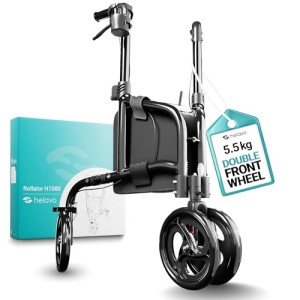Understanding Walking Aids: Enhancing Mobility and Independence
Walking aids play a vital role in boosting mobility and independence for individuals with differing degrees of physical limitations. They can significantly enhance the quality of life by providing support, stability, and self-confidence when moving around. This article checks out the different kinds of walking help, their benefits, elements to consider when selecting one, and responses to regularly asked concerns to help assist those looking for assistance.
Types of Walking Aids
Walking help been available in numerous forms, each developed to accommodate particular requirements. Let's take a better take a look at some typically used walking help:
| Type of Walking Aid | Description | Ideal For |
|---|---|---|
| Walking canes | A single stick that provides support and balance, typically made from wood or aluminum. | People with moderate instability or requiring very little support. |
| Walkers | Frames with four legs that provide stability and support for individuals who need more assistance than a cane can offer. | People with moderate mobility problems or recovering from surgical treatment. |
| Rollators | Similar to walkers but geared up with wheels, handbrakes, and a seat for resting. | Individuals who need mobility support however can walk brief ranges. |
| Crutches | 2 long poles that provide support by putting weight on the arms. They frequently require strength and coordination. | Individuals recovering from leg or foot injuries. |
| Mobility Scooters | Electrically powered scooters created for individuals with significant mobility impairments. | People who can not walk cross countries or have extreme physical restrictions. |
Advantages of Using Walking Aids
Including a walking aid can cause numerous benefits, consisting of:
- Increased Stability: Walking aids help in reducing the threat of falls by supplying additional support and balance.
- Improved Independence: Individuals can bring out day-to-day activities with higher ease and self-confidence, reducing the need for assistance from others.
- Discomfort Relief: Some walking aids help ease pain in the joints, such as hips or knees, by rearranging weight.
- Enhanced Posture: Many walking help encourage better posture, which can lead to reduced stress on muscles and joints.
- Physical Activity: A suitable walking aid motivates individuals to remain active, promoting cardiovascular health and general wellness.
Aspects to Consider When Choosing a Walking Aid
Choosing the ideal walking aid is crucial for optimizing its advantages. Here are several aspects to consider:
- Level of Mobility: Assess the person's ability to stroll independently and identify the level of support needed.
- Physical Strength: Consider upper body strength, as some help need more muscular control (e.g., crutches).
- Environment: Evaluate both indoor and outdoor environments to determine the very best kind of walking aid based on surfaces and challenges.
- Height and Size: Ensure that the walking aid fits the user correctly. The majority of help have adjustable height settings.
- Weight Capacity: Be aware of the weight limits of various aids to prevent potential mishaps or breakdowns.
Popular Walking Aids: A Quick Comparison
For a more simplified view of popular walking aids, here's a table comparing their viability for numerous requirements:
| Walking Aid Type | Support Level Needed | Perfect User Type | Weight Capacity | Mobility |
|---|---|---|---|---|
| Walking sticks | Low | Seniors, moderate injuries | Approximately 300 pounds | High |
| Walkers | Moderate | Post-operative, neuromuscular conditions | As much as 400 lbs | Medium |
| Rollators | Moderate to High | Elderly, active people needing rest | As much as 300 lbs | Medium |
| Crutches | Moderate to High | Injuries or surgeries | Differs commonly | Medium |
| Mobility Scooters | High | Limitations in leg strength | Approximately 500 lbs | Low |
Regularly Asked Questions (FAQs)
1. How do I know if I require a walking aid?It is advisable to
seek advice from with a health care expert or physical therapist if you experience difficulty walking, balance concerns, regular falls, or joint discomfort. They can recommend the best type of aid for your situation. 2. How must I use a cane properly?Position the cane on the side opposite to the injury or weak point. Hold it with the hand on that side while the walking stick supports motion on the injured side. Normally, the cane must progress with the hurt leg. 3. Can I use several walking aids?Yes, people might shift in between variousaids based on their mobility requires at any
time. For instance, an individual may utilize a walker in your home however transition to a walking cane when walking short distances outdoors. 4. How do I preserve my walking aid?Regularly check for wear and tear, especially on rubber tips for canes/walkers, and make sure wheels on rollators and scooters are functioning properly. Cleaning can assist extend the life of the aid. 5. Will insurance cover the expense of a walking aid?In lots of cases, medical insurance or Medicare might cover part or all of the cost of a clinically necessary walking aid.
It is essential to contact your insurance coverage company for specific guidelines. Walking help are vital tools that make it possible for individuals to restore self-reliance and improve their mobility. The proper choice based upon personal needs and choices can result in significant enhancements in quality
of life. With a range of alternatives available, individuals and caretakers should evaluate their unique situations carefully to select the most appropriate walking aid. Whether Ergonomic Walker 's an easy walking stick for support or a mobility scooter for those with extreme limitations, the ideal walking aid can make all the distinction in achieving better mobility, security, and eventually, a more active way of life.

